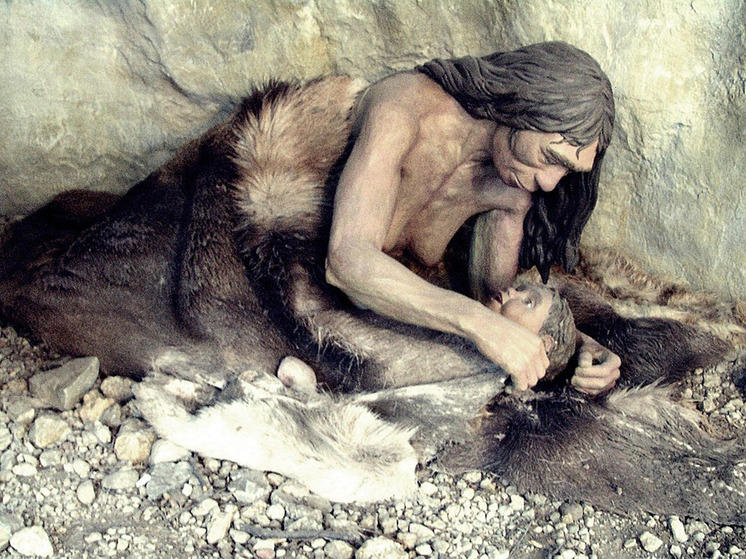Humans and Neanderthals lived side by side 45 thousand years ago
Bones found in an 8-meter-deep hole could “fundamentally change” human history in Europe. Microscopic fragments of protein and DNA recovered from bones found in cave mud showed that Neanderthals and humans likely lived side by side in northern Europe as early as 45,000 years ago.

Genetic analysis of fossils that were found in a cave near the town of Ranis in eastern Germany has revealed that modern humans were the creators of the distinctive leaf-shaped stone tools that archaeologists once believed were made by Neanderthals, large-bodied hominids who lived in Europe approximately 40,000 years ago.
As CNN notes, it was not previously known that modern humans, or Homo sapiens, lived as far north as in this region, where tools were made.
“Ranis Cave is evidence of the first dispersal of Homo sapiens into the higher latitudes of Europe. It turns out that stone artifacts thought to have been made by Neanderthals were actually part of the toolkit of early Homo sapiens, says study author Jean-Jacques Hublin, a professor at the Collège de France in Paris and director emeritus of the Max Planck Institute for Evolutionary Anthropology in Leipzig. – This fundamentally changes our previous knowledge of this period: Homo sapiens reached northwestern Europe long before the disappearance of Neanderthals in southwestern Europe.
The discovery means that the two groups that once interbred and left behind most modern humans with traces of Neanderthal DNA may have interbred for several thousand years. It also shows that Homo sapiens, our species, crossed the Alps and entered the cold climates of northern and central Europe earlier than thought, CNN notes.
Three studies detailing the findings and laboratory analysis have been published on Wednesday in Nature and Nature Ecology & Evolution.
According to research, the style of stone tools found at Ranis has also been found in other places throughout Europe, from Moravia and eastern Poland to the British Isles. Archaeologists call this style of tool Linkombian-Ranisi-Jerzmanowitz, or LRJ, after the places where it was first discovered.
To determine who made the artifacts, the team conducted excavations in the Ilzenhele cave near Ranis from 2016 to 2022. When the cave was first excavated in the 1930s, only tools were found and analyzed. This time the team was able to dig deeper and more systematically, eventually discovering human fossils there for the first time.
“The goal was to excavate the entire 8-meter sequence from top to bottom, hoping that some sediments remained from excavations in the 1930s,” notes study co-author Marcel Weiss, a researcher at the Friedrich-Alexander-University of Erlangen-Nuremberg and Max Planck Institute for Evolutionary Anthropology. – We were lucky to find a 1.7 meter thick rock that previous excavators could not overcome. After removing this rock by hand, we finally uncovered the layers of the LRJ and even found human fossils.
However, human remains were not immediately identified among the hundreds of bone fragments discovered during the six-year excavation. It was only later that the team finally learned that the layers of sediment that contained the LRJ stone tools also contained human remains.
The researchers used proteins extracted from bone fragments to identify the animal and human remains they found, a technique known as paleoproteomics. It allows scientists to identify human and animal bones when their shape is unclear. Using the same technique, the team was also able to identify human remains among bones excavated in the 1930s.
However, protein analysis allowed the bones to be identified only as belonging to hominins — a category that includes Homo sapiens and Homo neanderthalensis, or Neanderthals. To distinguish between them, the team was able to extract fragments of ancient DNA from the 13 human fossils they identified.
“We confirmed that the skeletal fragments belonged to Homo sapiens,”, study co-author Elena said in a press release Zavala, a research fellow at the University of California at Berkeley and the Max Planck Institute for Evolutionary Anthropology.
“Interestingly, several fragments had the same mitochondrial DNA sequences— even fragments from different excavations,” Zavala adds. “This indicates that the fragments belonged to the same person or were related on the mother's side, which links these new finds to those found decades ago.”
Radiocarbon dating of fossils and other artifacts in the cave showed that these early humans lived there approximately 45,000 years ago, making them the earliest members of the genus Homo sapiens known to inhabit northwestern Europe.
Then the region would have had a completely different climate, with conditions typical of the steppe tundra, for example, in modern Siberia. Excavations have revealed the presence of reindeer, cave bears, woolly rhinoceroses and horses. The researchers also concluded that hibernating cave bears and nesting hyenas primarily used the cave, which was only occasionally occupied by humans, CNN reports.
“This shows that even these early groups of Homo sapiens spreading across Eurasia already had some ability to adapt to such harsh climate conditions,” comments co-author Sara Pederzani, a researcher at the University of La Laguna in Spain, who led the study of the site's paleoclimate. “Until recently, resistance to cold climates was thought to have evolved only a few thousand years later, so this is an exciting and surprising result.”
William E. Banks, a researcher at the University of Bordeaux in France, said the research showed how new techniques allow archaeologists to examine sites in unprecedented detail, improving the ability to pinpoint when a site was occupied.
&ldquo “The discoveries represent another important piece of the puzzle of this culturally and demographically complex period in Europe,” Banks said in a commentary published along with the research. However, Banks, who was not involved in the study, added that archaeologists «must be careful not to generalize from one or two sites.»
He noted that recent discoveries suggest that Neanderthals were more culturally and cognitively complex than popular stereotypes suggest, and that archaeologists “need not assume” in all cases, modern humans made more complex stone tools from that key period before the disappearance of the Neanderthals.

























































Свежие комментарии